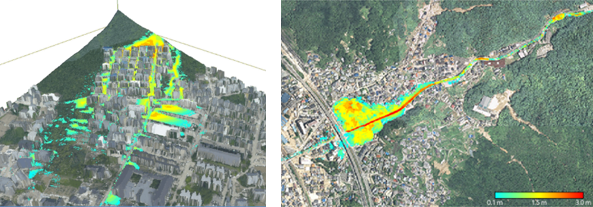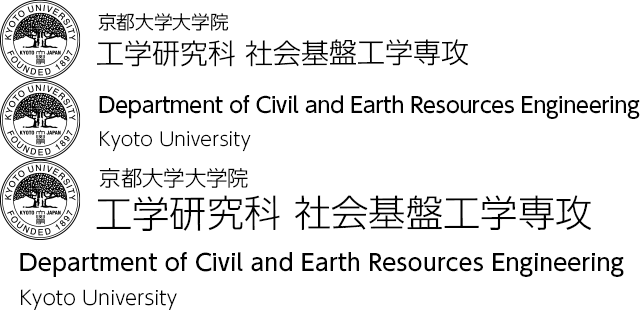Erosion and Sediment Runoff Control Engineering
United research to produce safe sound sediment environment in river basin
In a sediment transport system from mountainous area through river area to coastal area, disasters occur due to the various kinds of sediment transport phenomena. The phenomena and processes are important factor to produce safe sound sediment environment in river basin. To mitigate the disasters and to understand the dynamics of sediment transport and water in the sediment transport system, various field observations, hydraulic experiments, and development of simulation models and systems are carried out in our division.
Academic Staff
Kana NAKATANI
Professor (Disaster Prevention Research Institute)
Research Topics
My main research topics are sediment-related disasters such as debris flows and woody debris occur from mountainous areas. We are conducting research focusing on the mechanisms, behaviors and also effective disaster prevention measures with numerical simulations, hydraulic experiments, field surveys and observations.
Contacts
Ujigawa Open Laboratory, Disaster Prevention Research Institute
TEL: +81-75-611-5263
E-mail: nakatani.kana.4z kyoto-u.ac.jp
kyoto-u.ac.jp
Kazuki YAMANOI
Associate Professor (Disaster Prevention Research Institute)
Research Topics
My main research topics are quantification of the influence of sediment yield to inundation, damage estimation of the heavy rainfall disaster, and evacuation system during sediment-related disaster. These researches are conducted by developing an integrated numerical simulation system of the rainfall runoff, sediment yield, sediment runoff, and inundation.
Contacts
Ujigawa Open Laboratory Disaster Prevention Research Institute
TEL: +81-75-611-4397
FAX: +81-75-611-4397
E-mail: yamanoi.kazuki.6s kyoto-u.ac.jp
kyoto-u.ac.jp
Research Topics
Sediment Disaster Prevention
Landslides, debris flow, woody debris, and channel deformation cause sediment disasters. Recently, sedimentation and flood damage have become serious problem, in which sediment generated in mountainous areas moves downstream burying channels and causing damage. Sediment disaster prevention is one of the important social topics.
Our laboratory researches on the generation mechanism, prediction techniques, upgrading hazard map with various field observations, hydraulic experiments, and development of simulation models and systems. Recently, numerical simulations are applied for detail hazard zoning and for considering effective countermeasures.
Figure 1 shows the numerical analysis results of debris flow deposition in mountainous housing area(left) and sediment and flood damage simulation result (right).

Figure 1: Debris flow simulation result(left) and sediment and flood damage simulation result (right).
The debris flows mechanism is not fully understood due to the severe phenomena. We conduct field observations of fine sediment contents within debris flows, which contribute to elucidating the debris flow mechanism and simulation models improvement. Figure 2 shows our observation equipment installed in a debris flow-prone stream to observe the fine sediment content rate in debris flow.
Figure 2: Observation equipment in a debris flow-prone stream.
Sediment Runoff Processes in Sediment Transport System
Sediment is produced in mountainous areas and transported to coastal area through rivers. These processes are important factor to produce safe sound basin environment.
With field observations, hydraulic experiments and numerical analysis, we focus on sediment production mechanism and sediment transport processes. Figure 3 shows the field experiment with hydrophone system and other equipment to observe bed load in Hodaka Sedimentation Observatory.
Figure 3: Field experiment with hydrophone and other equipment to observe bed load in Hodaka Sedimentation Observatory.
When a sediment disaster occurs due to heavy rains or eruptions, a large amount of sediment is supplied to the basin. In our laboratory, we focus on not only sediment disasters but also themes including methods utilizing supplied sediment as a resource for the sound environment and ecosystems. We aim to propose and examine comprehensive sediment management methods.
Considering Safe Sediment Runoff Through Sediment Transport System
Capturing all the sediment runoff from mountainous area to coastal area through rivers with structures is difficult. Therefore, land use considering safe sediment runoff is required. Such as to capture large boulders and woody debris with sabo dams, control density and grain size and transport safely into bypasses and channels, and use some parks for sedimentation area.
Applying field surveys, observations, and simulations, we aim to consider safe urban development in cooperation with not only erosion control section but also rivers and reservoir sections.
